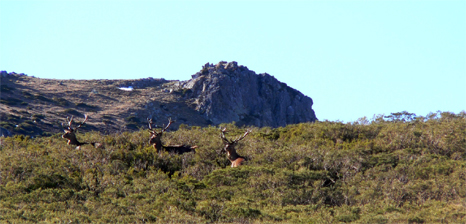With our houseparty-style holidays in the Palentian mountains of Spain proving ever more popular (and with Iberian Wolves once again putting in an appearance during our June 2011 tour), we talk to Tino Garcia, our host in Palencia, about his love of nature and the mountains.

Red Deer by Tino Garcia
It could be said that I was born into nature – in a small town called Revilla de Santullan in La Montana Palentina, on the slopes of the Cantabrian Mountains. I had to do no more than open the front door of our house to see forest and mountains, and as soon as I could walk and go out with my parents to explore the immediate environment outside, I did. At the age of eight, I went up the mountain to get my first views of the Capercaillie mating season (my mother was amazed that I’d been up since 4am!)
At weekends, when my father’s work allowed him (he worked in the coal mines), the three of us travelled to distant corners of La Montana Palentina, most often in the autumn and spring – the times of year when there were mushrooms.
At 14, I was marched from mountain to mountain and spent long hours watching the different animals that lived in these places. Imagine the eyes of a teenage boy discovering a group of Wolves eating their conquered prey, or a Brown Bear destroying an anthill, as well as marvelling at the numerous birds that came and went. And slowly I learnt, little by little, from an old guide book, and later from the famous television programme by TVE, ‘El Hombre y la Tierra’ (which I had to watch in the neighbours’ house as we had no television of our own!).
Since I did not really like studying, as soon as I’d finished my primary studies I started working as a plumber’s assistant. Only on Sundays, when I did not have to work, did I go to the countryside, but because of my work commitments, I had little time to go and do what I most wanted to do during that period. As the years passed I met my future wife, Rosa, changed my job, and had to start working away from my home – in Madrid, Oviedo, Bilbao, Santander and other cities – carrying out building restoration projects for the government. This did not allow me any time to enjoy the things I was most passionate about – my mountains, my Wolves, my Bears, my everything! I had to look for a ‘solution’ to this dilemma, something that would allow me to live in my own region, with Rosa and Ami (my daughter).
Starting to attract wildlife tourism to the area
The idea then occurred to us (almost 12 years ago now) of starting up some kind of rural tourism around our own home. Rosa, my father and I bought and renovated an old house then rented it out as rural accommodation. I began getting involved with various TV, magazine and newspaper organisations, all of which were related to nature in some way. Then we were involved in some botanical work for the government, and later we found there was an increasing demand for wildlife viewing and excursions from guests staying in our rural accommodation.
Setting up our first camera traps
We began setting camera traps in the area because one night, while Rosa and I were waiting for a few clients, we saw an animal that looked like a Beech Marten jumping over the wall by one of the rural houses. It was followed by two more – a whole family! We wanted to check if they were just passing or using one of the sheds as a place to rest during the day. So we bought one of the first cameras available on the market and set it up. We were soon able to confirm that the route where we’d seen the martens crossing was in fact an established pathway for a variety of different wildlife. We recorded martens, Wildcats and Weasels to name but a few. Camera traps are a great way of finding out which animals pass through various places and without this kind of recording device they’d pass by completely unnoticed. We get some of the best results when there’s carrion or some other source of food nearby – this often brings interesting surprises!
Wolves & Bears
Our region has both Wolves and Bears still. I think that the Wolf will be able to survive in the area because they always have; and although they are chased, harassed and killed, they are born survivors. For the Bear, I believe that as the years pass and much of the area in which they are now living disappears, they will struggle. Unlike Wolves, Bears have not learnt to coexist in a world that is being so drastically and rapidly changed by mankind. They are critically endangered on the Iberian Peninsula and their existence is on a knife edge. In addition the small population of Brown Bears that we have in Montana Palentina is further constricted by the fact that it’s an ancient lineage which has its genetic roots in Scandinavia; I predict that this will make surviving climate change very difficult for the Bears. On top of all the other factors working against the Bears the different administrations are doing nothing to conserve and preserve these natural jewels! Join Tino in the mountains of northern Spain on our popular Wild Spain and Learning Spanish weeks.
Our popular 5-day 'Wolf-watching in Spain' tour provides a great opportunity to search for Iberian Wolves (with around an 80% success rate), with chances to see Brown Bear and Wildcat. For more information click here.



 Loading search...
Loading search...